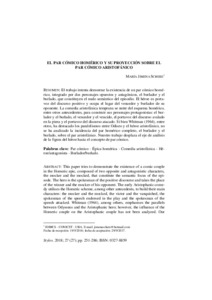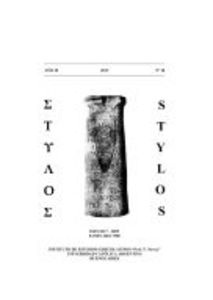Por favor, use este identificador para citar o enlazar este ítem:
https://repositorio.uca.edu.ar/handle/123456789/9753| Título: | El par cómico homérico y su proyección sobre el par cómico aristofánico | Autor: | Schere, María Jimena | Palabras clave: | COMEDIA; EPICA; Homero; Aristófanes, ca. 450-ca. 385 a. C.; HEROES; LITERATURA GRIEGA; PERSONAJES | Fecha de publicación: | 2018 | Editorial: | Universidad Católica Argentina. Facultad de Filosofía y Letras. Instituto de estudios grecolatinos "Prof. F. Nóvoa" | Cita: | Schere, M. J. El par cómico homérico y su proyección sobre el par cómico aristofánico. [en línea]. Stylos, 2018, 27. Dispinible en: https://repositorio.uca.edu.ar/handle/123456789/9753 | Resumen: | Resumen: El trabajo intenta demostrar la existencia de un par cómico homé-rico, integrado por dos personajes opuestos y antagónicos, el burlador y el burlado, que constituyen el nudo semántico del episodio. El héroe es porta-voz del discurso positivo y ocupa el lugar del vencedor y burlador de su oponente. La comedia aristofánica temprana se nutre del esquema homérico, entre otros antecedentes, para construir sus personajes protagonistas: el bur-lador y el burlado, el vencedor y el vencido, el portavoz del discurso avalado en la pieza y el portavoz del discurso atacado. Si bien Whitman (1964), entre otros, ha destacado los paralelismos entre Odiseo y el héroe aristofánico, no se ha analizado la incidencia del par homérico completo, el burlador y el burlado, sobre el par aristofánico. Nuestro trabajo desplaza el eje de análisis de la figura del héroe hacia el concepto de par cómico. Abstract: This paper tries to demonstrate the existence of a comic couple in the Homeric epic, composed of two opposite and antagonistic characters, the mocker and the mocked, that constitute the semantic focus of the epi-sode. The hero is the spokesman of the positive discourse and takes the place of the winner and the mocker of his opponent. The early Aristophanic come-dy utilises the Homeric scheme, among other antecedents, to build their main characters: the mocker and the mocked, the victor and the vanquished, the spokesman of the speech endorsed in the play and the spokesman of the speech attacked. Whitman (1964), among others, emphasises the parallels between Odysseus and the Aristophanic hero; however, the influence of the Homeric couple on the Aristophanic couple has not been analyzed. Our analysis focuses the concept of comic couple instead of the concept of comic hero. |
URI: | https://repositorio.uca.edu.ar/handle/123456789/9753 | ISSN: | 0327-8859 | Disciplina: | LITERATURA | Derechos: | Acceso abierto | Fuente: | Stylos Nº 27, 2018 |
| Aparece en las colecciones: | STY - 2018 nro. 27 |
Ficheros en este ítem:
| Fichero | Descripción | Tamaño | Formato | |
|---|---|---|---|---|
| par-comico-homerico-proyeccion.pdf | 444,83 kB | Adobe PDF |  View/Open | |
| stylos27.jpg | 297,44 kB | JPEG |  View/Open |
Page view(s)
87
checked on Apr 30, 2024
Download(s)
99
checked on Apr 30, 2024
Google ScholarTM
Check
This item is licensed under a Creative Commons License

